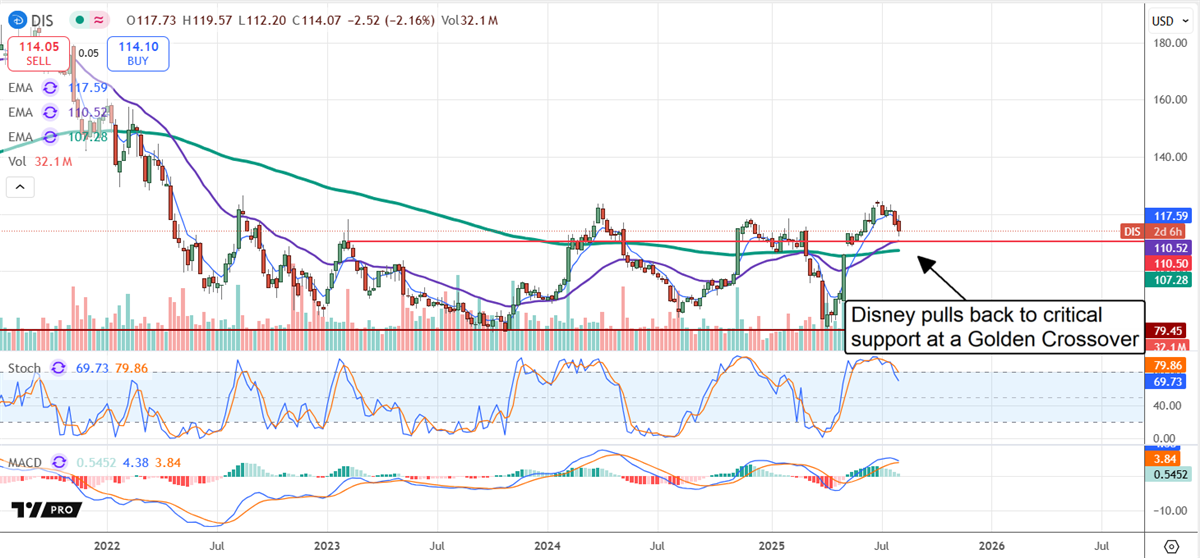Disney’s Iger-Led Turnaround Gains Traction

The Walt Disney Company (NYSE: DIS) faces headwinds in 2025, as do most businesses, but the Q2 results reveal the enduring strength of the brand and the impact of Bob Iger’s return. While revenue headwinds persist for this entertainment company, the company continues to grow, and profitability is improving.
The critical detail is that profitability improved across key operating metrics, driving a significant bottom-line outperformance despite the tepid top-line. The takeaway for investors is that this company has regained its lost leverage, is well-positioned for an economic rebound, and the capital return outlook is rapidly improving.
Disney Sets Up for a Rally in Q3
Disney’s stock price action declined following the FQ3 release, setting it up to rally as the calendar quarter progresses. The move took the market to a critical support level that aligns with prior resistance and key moving averages, and support appears to be present.
The market may consolidate at this level, but assuming no new low is set, a new high is likely to occur soon. The moving averages have formed a Golden Crossover, indicating a shift in market dynamics from a less-bullish to a more-bullish posture, which is a signal to buy.

Disney’s Diversified Business Supports Growth in Q2
Disney didn’t have an easy time in Q2, but its diversified business model and refocus on quality are paying off. The $23.65 billion in net revenue is up 2.1% compared to last year, with strength in Entertainment and Experiences offsetting Sports.
Entertainment grew by only 1%, led by an 8% increase in Experiences and offset by a 5% decline in Sports. Within the Entertainment segment, DTC and licensing are the standouts, while in Experiences, the domestic parks led the strength.
The only bad news is that the analysts had been expecting a little more.
The margin news is also mixed, with one segment contracting and the others expanding. The net result is that EBIT grew by 4%, segment operating income by 8%, adjusted earnings by 16%, cash from operations by 41%, and free cash flow by 51%, with adjusted earnings outpacing the consensus by nearly 1200 basis points.
The guidance echoes the clear sign of strength, which is why this stock is a buy in Q3. Given the underlying strengths, the company raised its full-year profit targets to a range above the consensus and may exceed the target.
The focus on streaming and sports is a reason to bet on Disney’s long-term stock price recovery. The company is integrating Hulu and Disney+, making it a more attractive and comprehensive streaming solution, and rationalizing its ESPS networks. ESPN's focus includes acquiring the NFL’s media assets and integrating them into the streaming portfolio.
The Iger Impact Is Clearly Seen in Disney’s Balance Sheet
Bob Iger’s impact on the business is visible in the balance sheet. Highlights include reduced cash, which is balanced by steady assets, decreased debt and total liabilities, and a 7% rise in equity.
The increase in equity is especially significant considering the share buybacks, which lowered the share count by 1.2%, effectively using cash while increasing shareholder value.
The buybacks and dividend payments are expected to continue steadily through the end of the year and into next year. The dividend remains reliable at less than 20% of forecasted earnings and is expected to rise in 2026.
The analyst and institutions are bullish on Disney’s turnaround and capital return. The 24 analysts tracked by MarketBeat rate the stock as Moderate Buy with bullish bias, see it advancing to a multiyear high in 2025, and the institutions are buying on balance.
The institutional activity provides a strong tailwind for the market, owning 66% of the stock and buying at a two-to-one pace in Q3.
Learn more about DIS


